Environmental Impacts and Human Health
VerifiedAdded on 2020/05/16
|10
|4068
|97
AI Summary
This assignment delves into the multifaceted relationship between environmental factors and human health. It examines the detrimental effects of UV radiation, ozone depletion, and climate change on various aspects of human well-being. The provided sources highlight the scientific evidence linking these environmental stressors to skin disorders, vitamin D deficiency, and other health issues. Furthermore, the assignment emphasizes the importance of understanding the global impact of these environmental changes and the need for sustainable solutions to mitigate their adverse effects on human populations.
Contribute Materials
Your contribution can guide someone’s learning journey. Share your
documents today.

Running head: AUSTRALIAN OZONE LAYER
Australian Ozone Layer
Name of the Student
Name of the University
Author note
Australian Ozone Layer
Name of the Student
Name of the University
Author note
Secure Best Marks with AI Grader
Need help grading? Try our AI Grader for instant feedback on your assignments.
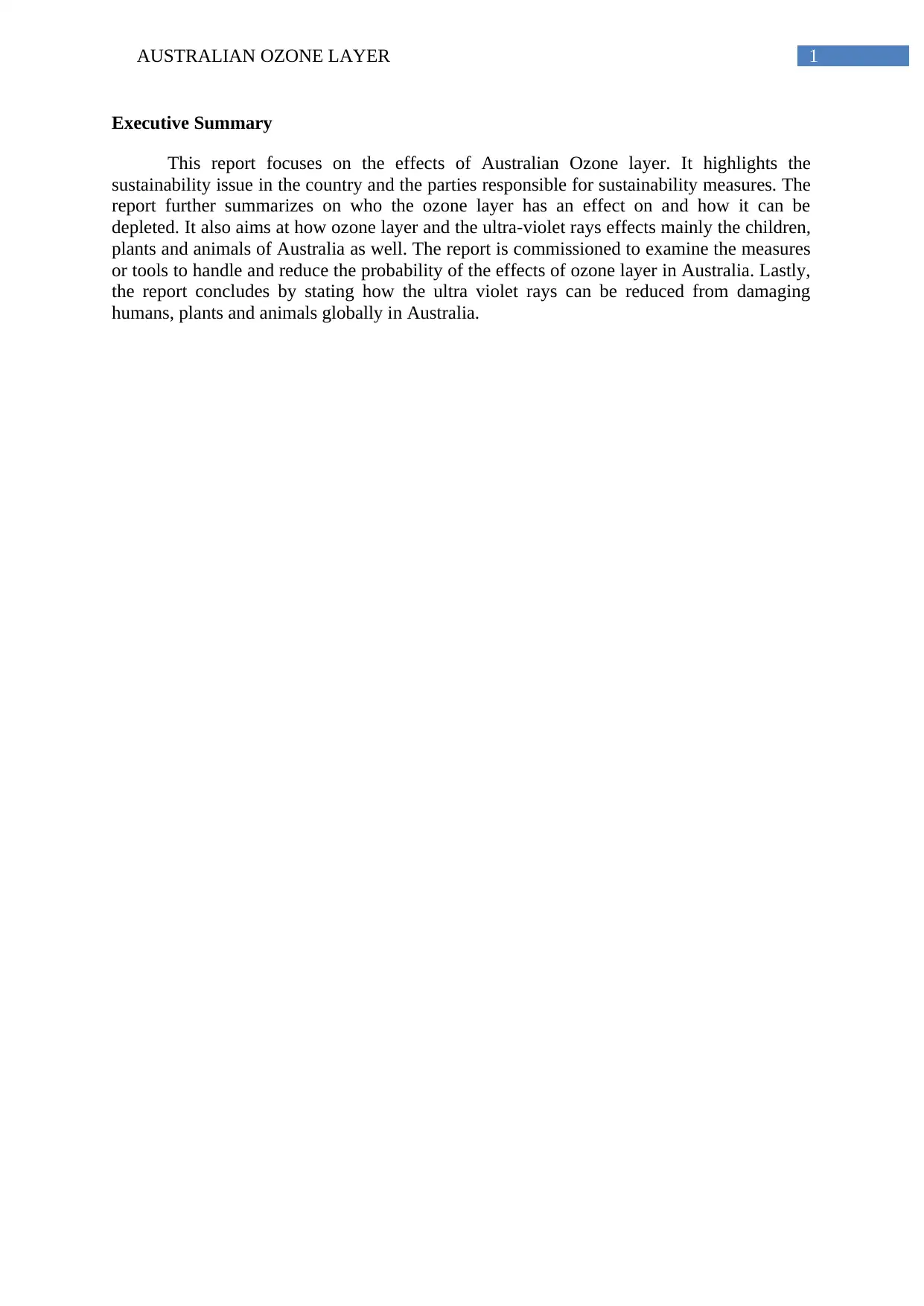
1AUSTRALIAN OZONE LAYER
Executive Summary
This report focuses on the effects of Australian Ozone layer. It highlights the
sustainability issue in the country and the parties responsible for sustainability measures. The
report further summarizes on who the ozone layer has an effect on and how it can be
depleted. It also aims at how ozone layer and the ultra-violet rays effects mainly the children,
plants and animals of Australia as well. The report is commissioned to examine the measures
or tools to handle and reduce the probability of the effects of ozone layer in Australia. Lastly,
the report concludes by stating how the ultra violet rays can be reduced from damaging
humans, plants and animals globally in Australia.
Executive Summary
This report focuses on the effects of Australian Ozone layer. It highlights the
sustainability issue in the country and the parties responsible for sustainability measures. The
report further summarizes on who the ozone layer has an effect on and how it can be
depleted. It also aims at how ozone layer and the ultra-violet rays effects mainly the children,
plants and animals of Australia as well. The report is commissioned to examine the measures
or tools to handle and reduce the probability of the effects of ozone layer in Australia. Lastly,
the report concludes by stating how the ultra violet rays can be reduced from damaging
humans, plants and animals globally in Australia.
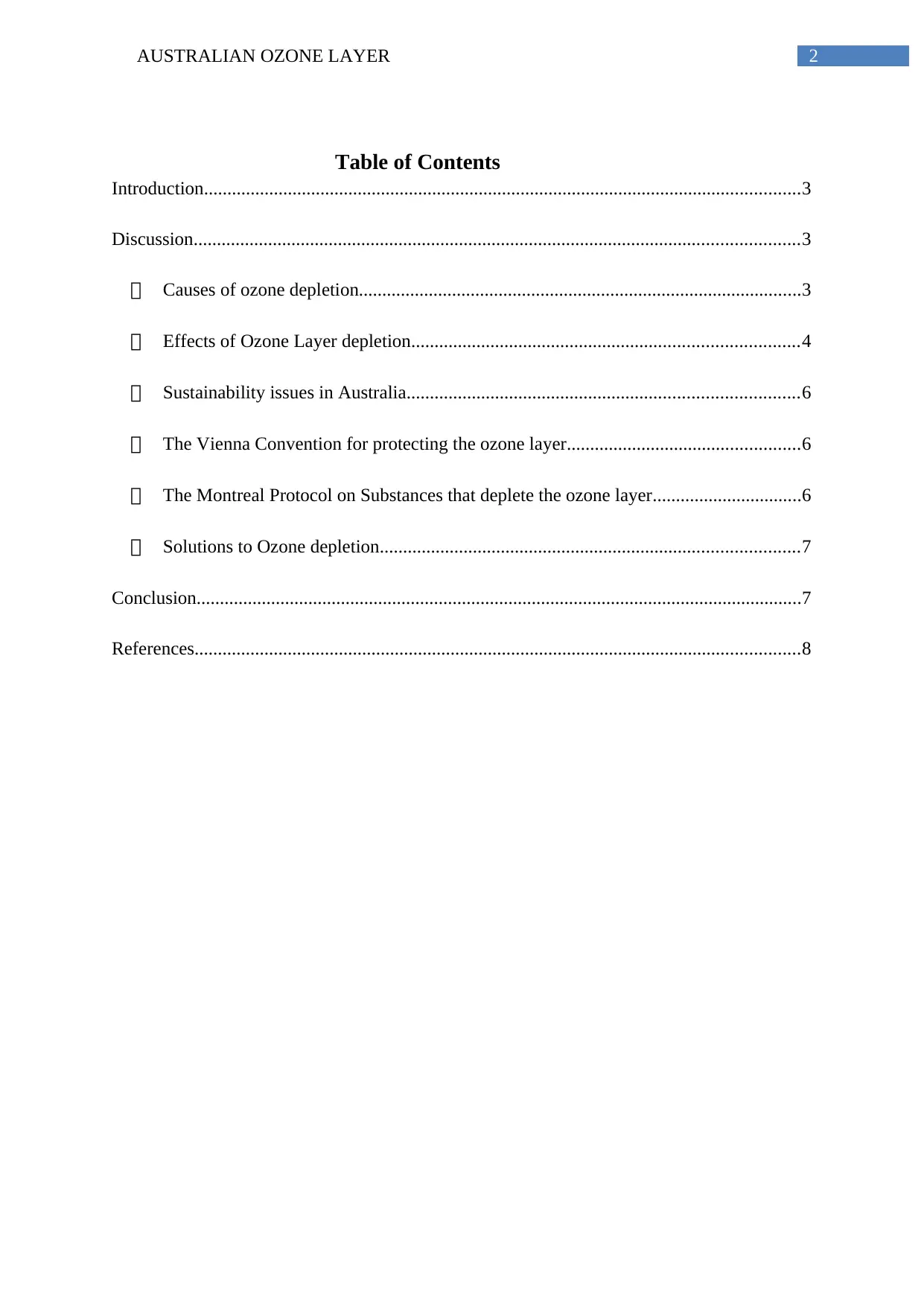
2AUSTRALIAN OZONE LAYER
Table of Contents
Introduction................................................................................................................................3
Discussion..................................................................................................................................3
Causes of ozone depletion...............................................................................................3
Effects of Ozone Layer depletion...................................................................................4
Sustainability issues in Australia....................................................................................6
The Vienna Convention for protecting the ozone layer..................................................6
The Montreal Protocol on Substances that deplete the ozone layer................................6
Solutions to Ozone depletion..........................................................................................7
Conclusion..................................................................................................................................7
References..................................................................................................................................8
Table of Contents
Introduction................................................................................................................................3
Discussion..................................................................................................................................3
Causes of ozone depletion...............................................................................................3
Effects of Ozone Layer depletion...................................................................................4
Sustainability issues in Australia....................................................................................6
The Vienna Convention for protecting the ozone layer..................................................6
The Montreal Protocol on Substances that deplete the ozone layer................................6
Solutions to Ozone depletion..........................................................................................7
Conclusion..................................................................................................................................7
References..................................................................................................................................8
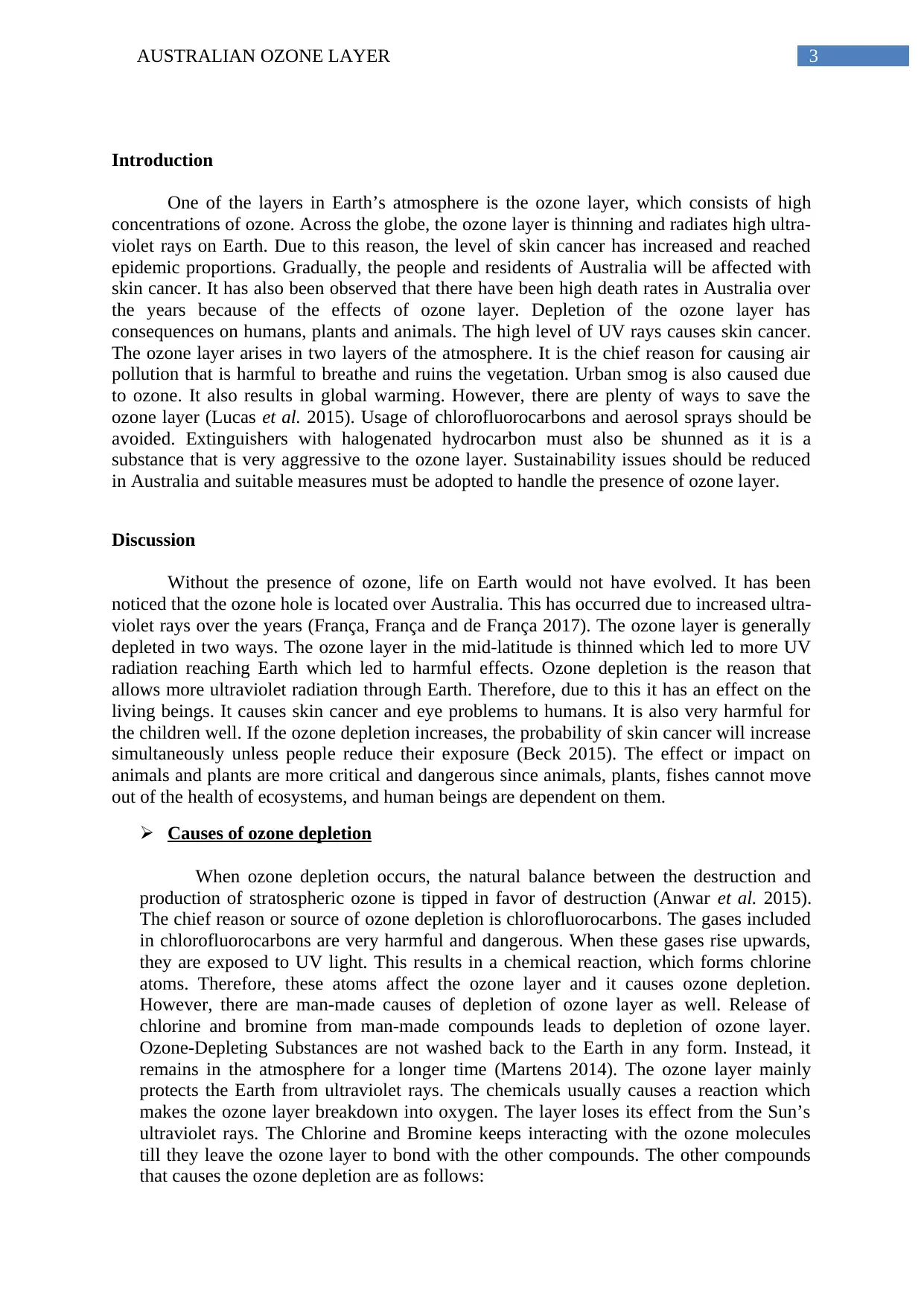
3AUSTRALIAN OZONE LAYER
Introduction
One of the layers in Earth’s atmosphere is the ozone layer, which consists of high
concentrations of ozone. Across the globe, the ozone layer is thinning and radiates high ultra-
violet rays on Earth. Due to this reason, the level of skin cancer has increased and reached
epidemic proportions. Gradually, the people and residents of Australia will be affected with
skin cancer. It has also been observed that there have been high death rates in Australia over
the years because of the effects of ozone layer. Depletion of the ozone layer has
consequences on humans, plants and animals. The high level of UV rays causes skin cancer.
The ozone layer arises in two layers of the atmosphere. It is the chief reason for causing air
pollution that is harmful to breathe and ruins the vegetation. Urban smog is also caused due
to ozone. It also results in global warming. However, there are plenty of ways to save the
ozone layer (Lucas et al. 2015). Usage of chlorofluorocarbons and aerosol sprays should be
avoided. Extinguishers with halogenated hydrocarbon must also be shunned as it is a
substance that is very aggressive to the ozone layer. Sustainability issues should be reduced
in Australia and suitable measures must be adopted to handle the presence of ozone layer.
Discussion
Without the presence of ozone, life on Earth would not have evolved. It has been
noticed that the ozone hole is located over Australia. This has occurred due to increased ultra-
violet rays over the years (França, França and de França 2017). The ozone layer is generally
depleted in two ways. The ozone layer in the mid-latitude is thinned which led to more UV
radiation reaching Earth which led to harmful effects. Ozone depletion is the reason that
allows more ultraviolet radiation through Earth. Therefore, due to this it has an effect on the
living beings. It causes skin cancer and eye problems to humans. It is also very harmful for
the children well. If the ozone depletion increases, the probability of skin cancer will increase
simultaneously unless people reduce their exposure (Beck 2015). The effect or impact on
animals and plants are more critical and dangerous since animals, plants, fishes cannot move
out of the health of ecosystems, and human beings are dependent on them.
Causes of ozone depletion
When ozone depletion occurs, the natural balance between the destruction and
production of stratospheric ozone is tipped in favor of destruction (Anwar et al. 2015).
The chief reason or source of ozone depletion is chlorofluorocarbons. The gases included
in chlorofluorocarbons are very harmful and dangerous. When these gases rise upwards,
they are exposed to UV light. This results in a chemical reaction, which forms chlorine
atoms. Therefore, these atoms affect the ozone layer and it causes ozone depletion.
However, there are man-made causes of depletion of ozone layer as well. Release of
chlorine and bromine from man-made compounds leads to depletion of ozone layer.
Ozone-Depleting Substances are not washed back to the Earth in any form. Instead, it
remains in the atmosphere for a longer time (Martens 2014). The ozone layer mainly
protects the Earth from ultraviolet rays. The chemicals usually causes a reaction which
makes the ozone layer breakdown into oxygen. The layer loses its effect from the Sun’s
ultraviolet rays. The Chlorine and Bromine keeps interacting with the ozone molecules
till they leave the ozone layer to bond with the other compounds. The other compounds
that causes the ozone depletion are as follows:
Introduction
One of the layers in Earth’s atmosphere is the ozone layer, which consists of high
concentrations of ozone. Across the globe, the ozone layer is thinning and radiates high ultra-
violet rays on Earth. Due to this reason, the level of skin cancer has increased and reached
epidemic proportions. Gradually, the people and residents of Australia will be affected with
skin cancer. It has also been observed that there have been high death rates in Australia over
the years because of the effects of ozone layer. Depletion of the ozone layer has
consequences on humans, plants and animals. The high level of UV rays causes skin cancer.
The ozone layer arises in two layers of the atmosphere. It is the chief reason for causing air
pollution that is harmful to breathe and ruins the vegetation. Urban smog is also caused due
to ozone. It also results in global warming. However, there are plenty of ways to save the
ozone layer (Lucas et al. 2015). Usage of chlorofluorocarbons and aerosol sprays should be
avoided. Extinguishers with halogenated hydrocarbon must also be shunned as it is a
substance that is very aggressive to the ozone layer. Sustainability issues should be reduced
in Australia and suitable measures must be adopted to handle the presence of ozone layer.
Discussion
Without the presence of ozone, life on Earth would not have evolved. It has been
noticed that the ozone hole is located over Australia. This has occurred due to increased ultra-
violet rays over the years (França, França and de França 2017). The ozone layer is generally
depleted in two ways. The ozone layer in the mid-latitude is thinned which led to more UV
radiation reaching Earth which led to harmful effects. Ozone depletion is the reason that
allows more ultraviolet radiation through Earth. Therefore, due to this it has an effect on the
living beings. It causes skin cancer and eye problems to humans. It is also very harmful for
the children well. If the ozone depletion increases, the probability of skin cancer will increase
simultaneously unless people reduce their exposure (Beck 2015). The effect or impact on
animals and plants are more critical and dangerous since animals, plants, fishes cannot move
out of the health of ecosystems, and human beings are dependent on them.
Causes of ozone depletion
When ozone depletion occurs, the natural balance between the destruction and
production of stratospheric ozone is tipped in favor of destruction (Anwar et al. 2015).
The chief reason or source of ozone depletion is chlorofluorocarbons. The gases included
in chlorofluorocarbons are very harmful and dangerous. When these gases rise upwards,
they are exposed to UV light. This results in a chemical reaction, which forms chlorine
atoms. Therefore, these atoms affect the ozone layer and it causes ozone depletion.
However, there are man-made causes of depletion of ozone layer as well. Release of
chlorine and bromine from man-made compounds leads to depletion of ozone layer.
Ozone-Depleting Substances are not washed back to the Earth in any form. Instead, it
remains in the atmosphere for a longer time (Martens 2014). The ozone layer mainly
protects the Earth from ultraviolet rays. The chemicals usually causes a reaction which
makes the ozone layer breakdown into oxygen. The layer loses its effect from the Sun’s
ultraviolet rays. The Chlorine and Bromine keeps interacting with the ozone molecules
till they leave the ozone layer to bond with the other compounds. The other compounds
that causes the ozone depletion are as follows:
Secure Best Marks with AI Grader
Need help grading? Try our AI Grader for instant feedback on your assignments.
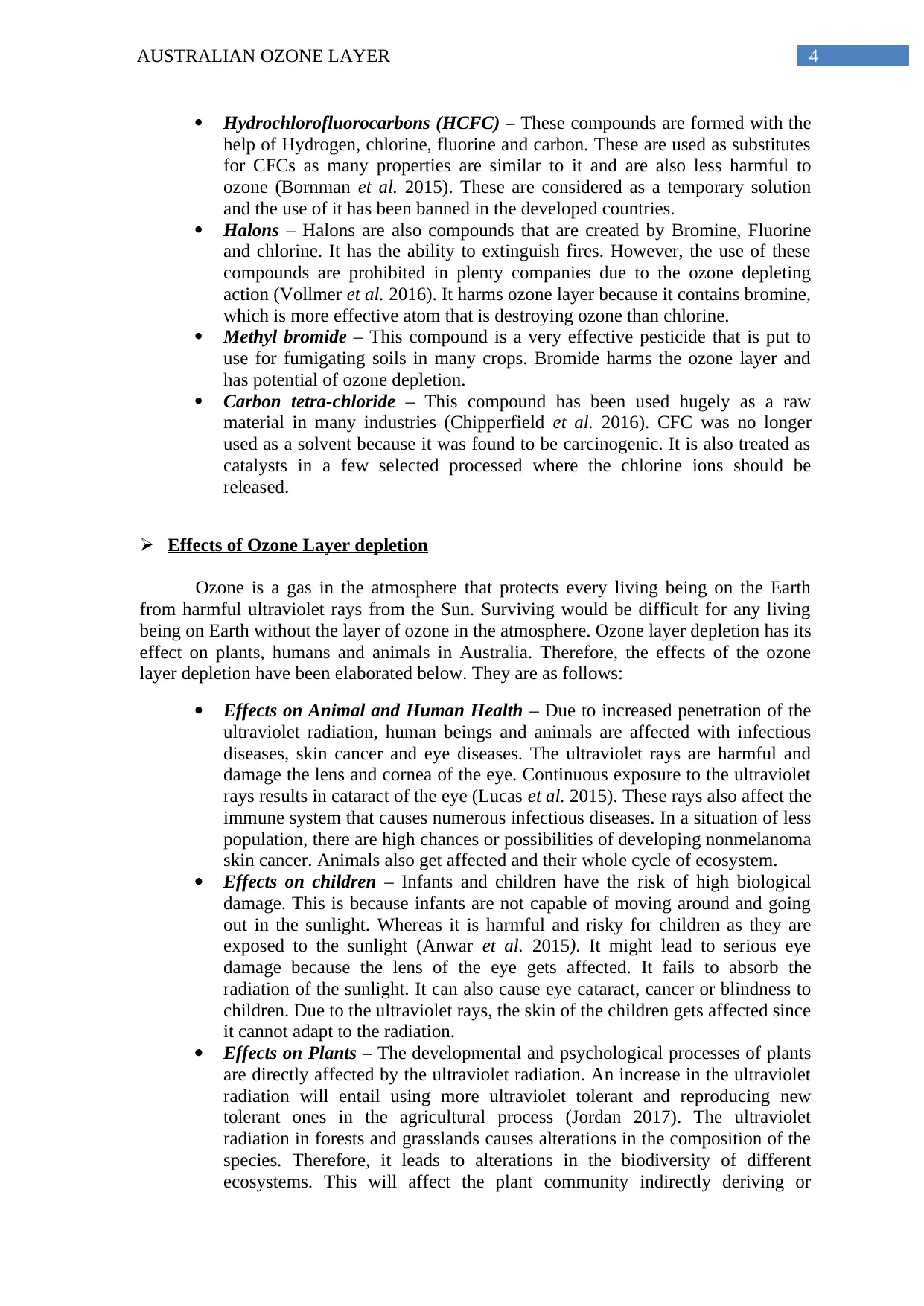
4AUSTRALIAN OZONE LAYER
Hydrochlorofluorocarbons (HCFC) – These compounds are formed with the
help of Hydrogen, chlorine, fluorine and carbon. These are used as substitutes
for CFCs as many properties are similar to it and are also less harmful to
ozone (Bornman et al. 2015). These are considered as a temporary solution
and the use of it has been banned in the developed countries.
Halons – Halons are also compounds that are created by Bromine, Fluorine
and chlorine. It has the ability to extinguish fires. However, the use of these
compounds are prohibited in plenty companies due to the ozone depleting
action (Vollmer et al. 2016). It harms ozone layer because it contains bromine,
which is more effective atom that is destroying ozone than chlorine.
Methyl bromide – This compound is a very effective pesticide that is put to
use for fumigating soils in many crops. Bromide harms the ozone layer and
has potential of ozone depletion.
Carbon tetra-chloride – This compound has been used hugely as a raw
material in many industries (Chipperfield et al. 2016). CFC was no longer
used as a solvent because it was found to be carcinogenic. It is also treated as
catalysts in a few selected processed where the chlorine ions should be
released.
Effects of Ozone Layer depletion
Ozone is a gas in the atmosphere that protects every living being on the Earth
from harmful ultraviolet rays from the Sun. Surviving would be difficult for any living
being on Earth without the layer of ozone in the atmosphere. Ozone layer depletion has its
effect on plants, humans and animals in Australia. Therefore, the effects of the ozone
layer depletion have been elaborated below. They are as follows:
Effects on Animal and Human Health – Due to increased penetration of the
ultraviolet radiation, human beings and animals are affected with infectious
diseases, skin cancer and eye diseases. The ultraviolet rays are harmful and
damage the lens and cornea of the eye. Continuous exposure to the ultraviolet
rays results in cataract of the eye (Lucas et al. 2015). These rays also affect the
immune system that causes numerous infectious diseases. In a situation of less
population, there are high chances or possibilities of developing nonmelanoma
skin cancer. Animals also get affected and their whole cycle of ecosystem.
Effects on children – Infants and children have the risk of high biological
damage. This is because infants are not capable of moving around and going
out in the sunlight. Whereas it is harmful and risky for children as they are
exposed to the sunlight (Anwar et al. 2015). It might lead to serious eye
damage because the lens of the eye gets affected. It fails to absorb the
radiation of the sunlight. It can also cause eye cataract, cancer or blindness to
children. Due to the ultraviolet rays, the skin of the children gets affected since
it cannot adapt to the radiation.
Effects on Plants – The developmental and psychological processes of plants
are directly affected by the ultraviolet radiation. An increase in the ultraviolet
radiation will entail using more ultraviolet tolerant and reproducing new
tolerant ones in the agricultural process (Jordan 2017). The ultraviolet
radiation in forests and grasslands causes alterations in the composition of the
species. Therefore, it leads to alterations in the biodiversity of different
ecosystems. This will affect the plant community indirectly deriving or
Hydrochlorofluorocarbons (HCFC) – These compounds are formed with the
help of Hydrogen, chlorine, fluorine and carbon. These are used as substitutes
for CFCs as many properties are similar to it and are also less harmful to
ozone (Bornman et al. 2015). These are considered as a temporary solution
and the use of it has been banned in the developed countries.
Halons – Halons are also compounds that are created by Bromine, Fluorine
and chlorine. It has the ability to extinguish fires. However, the use of these
compounds are prohibited in plenty companies due to the ozone depleting
action (Vollmer et al. 2016). It harms ozone layer because it contains bromine,
which is more effective atom that is destroying ozone than chlorine.
Methyl bromide – This compound is a very effective pesticide that is put to
use for fumigating soils in many crops. Bromide harms the ozone layer and
has potential of ozone depletion.
Carbon tetra-chloride – This compound has been used hugely as a raw
material in many industries (Chipperfield et al. 2016). CFC was no longer
used as a solvent because it was found to be carcinogenic. It is also treated as
catalysts in a few selected processed where the chlorine ions should be
released.
Effects of Ozone Layer depletion
Ozone is a gas in the atmosphere that protects every living being on the Earth
from harmful ultraviolet rays from the Sun. Surviving would be difficult for any living
being on Earth without the layer of ozone in the atmosphere. Ozone layer depletion has its
effect on plants, humans and animals in Australia. Therefore, the effects of the ozone
layer depletion have been elaborated below. They are as follows:
Effects on Animal and Human Health – Due to increased penetration of the
ultraviolet radiation, human beings and animals are affected with infectious
diseases, skin cancer and eye diseases. The ultraviolet rays are harmful and
damage the lens and cornea of the eye. Continuous exposure to the ultraviolet
rays results in cataract of the eye (Lucas et al. 2015). These rays also affect the
immune system that causes numerous infectious diseases. In a situation of less
population, there are high chances or possibilities of developing nonmelanoma
skin cancer. Animals also get affected and their whole cycle of ecosystem.
Effects on children – Infants and children have the risk of high biological
damage. This is because infants are not capable of moving around and going
out in the sunlight. Whereas it is harmful and risky for children as they are
exposed to the sunlight (Anwar et al. 2015). It might lead to serious eye
damage because the lens of the eye gets affected. It fails to absorb the
radiation of the sunlight. It can also cause eye cataract, cancer or blindness to
children. Due to the ultraviolet rays, the skin of the children gets affected since
it cannot adapt to the radiation.
Effects on Plants – The developmental and psychological processes of plants
are directly affected by the ultraviolet radiation. An increase in the ultraviolet
radiation will entail using more ultraviolet tolerant and reproducing new
tolerant ones in the agricultural process (Jordan 2017). The ultraviolet
radiation in forests and grasslands causes alterations in the composition of the
species. Therefore, it leads to alterations in the biodiversity of different
ecosystems. This will affect the plant community indirectly deriving or
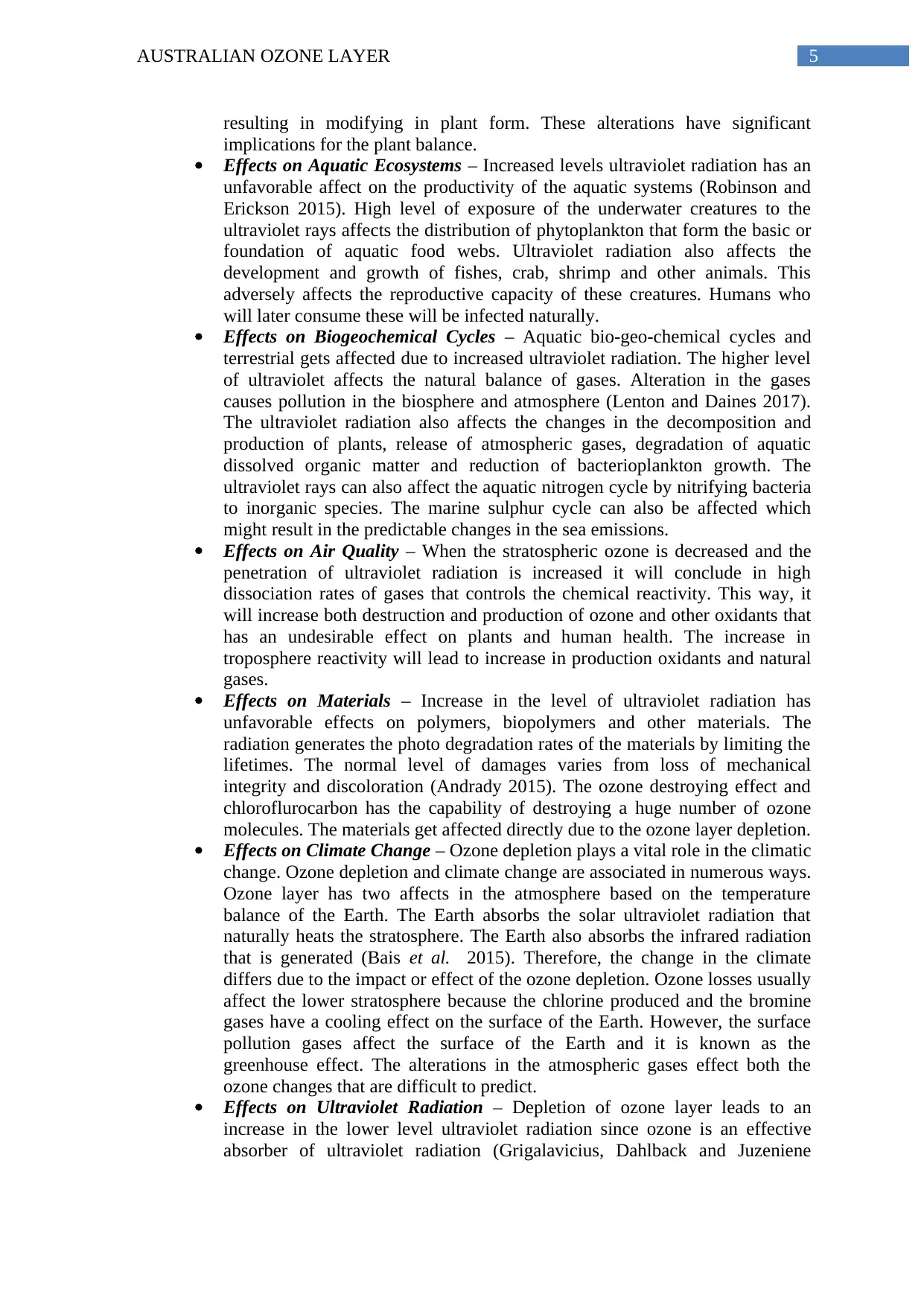
5AUSTRALIAN OZONE LAYER
resulting in modifying in plant form. These alterations have significant
implications for the plant balance.
Effects on Aquatic Ecosystems – Increased levels ultraviolet radiation has an
unfavorable affect on the productivity of the aquatic systems (Robinson and
Erickson 2015). High level of exposure of the underwater creatures to the
ultraviolet rays affects the distribution of phytoplankton that form the basic or
foundation of aquatic food webs. Ultraviolet radiation also affects the
development and growth of fishes, crab, shrimp and other animals. This
adversely affects the reproductive capacity of these creatures. Humans who
will later consume these will be infected naturally.
Effects on Biogeochemical Cycles – Aquatic bio-geo-chemical cycles and
terrestrial gets affected due to increased ultraviolet radiation. The higher level
of ultraviolet affects the natural balance of gases. Alteration in the gases
causes pollution in the biosphere and atmosphere (Lenton and Daines 2017).
The ultraviolet radiation also affects the changes in the decomposition and
production of plants, release of atmospheric gases, degradation of aquatic
dissolved organic matter and reduction of bacterioplankton growth. The
ultraviolet rays can also affect the aquatic nitrogen cycle by nitrifying bacteria
to inorganic species. The marine sulphur cycle can also be affected which
might result in the predictable changes in the sea emissions.
Effects on Air Quality – When the stratospheric ozone is decreased and the
penetration of ultraviolet radiation is increased it will conclude in high
dissociation rates of gases that controls the chemical reactivity. This way, it
will increase both destruction and production of ozone and other oxidants that
has an undesirable effect on plants and human health. The increase in
troposphere reactivity will lead to increase in production oxidants and natural
gases.
Effects on Materials – Increase in the level of ultraviolet radiation has
unfavorable effects on polymers, biopolymers and other materials. The
radiation generates the photo degradation rates of the materials by limiting the
lifetimes. The normal level of damages varies from loss of mechanical
integrity and discoloration (Andrady 2015). The ozone destroying effect and
chloroflurocarbon has the capability of destroying a huge number of ozone
molecules. The materials get affected directly due to the ozone layer depletion.
Effects on Climate Change – Ozone depletion plays a vital role in the climatic
change. Ozone depletion and climate change are associated in numerous ways.
Ozone layer has two affects in the atmosphere based on the temperature
balance of the Earth. The Earth absorbs the solar ultraviolet radiation that
naturally heats the stratosphere. The Earth also absorbs the infrared radiation
that is generated (Bais et al. 2015). Therefore, the change in the climate
differs due to the impact or effect of the ozone depletion. Ozone losses usually
affect the lower stratosphere because the chlorine produced and the bromine
gases have a cooling effect on the surface of the Earth. However, the surface
pollution gases affect the surface of the Earth and it is known as the
greenhouse effect. The alterations in the atmospheric gases effect both the
ozone changes that are difficult to predict.
Effects on Ultraviolet Radiation – Depletion of ozone layer leads to an
increase in the lower level ultraviolet radiation since ozone is an effective
absorber of ultraviolet radiation (Grigalavicius, Dahlback and Juzeniene
resulting in modifying in plant form. These alterations have significant
implications for the plant balance.
Effects on Aquatic Ecosystems – Increased levels ultraviolet radiation has an
unfavorable affect on the productivity of the aquatic systems (Robinson and
Erickson 2015). High level of exposure of the underwater creatures to the
ultraviolet rays affects the distribution of phytoplankton that form the basic or
foundation of aquatic food webs. Ultraviolet radiation also affects the
development and growth of fishes, crab, shrimp and other animals. This
adversely affects the reproductive capacity of these creatures. Humans who
will later consume these will be infected naturally.
Effects on Biogeochemical Cycles – Aquatic bio-geo-chemical cycles and
terrestrial gets affected due to increased ultraviolet radiation. The higher level
of ultraviolet affects the natural balance of gases. Alteration in the gases
causes pollution in the biosphere and atmosphere (Lenton and Daines 2017).
The ultraviolet radiation also affects the changes in the decomposition and
production of plants, release of atmospheric gases, degradation of aquatic
dissolved organic matter and reduction of bacterioplankton growth. The
ultraviolet rays can also affect the aquatic nitrogen cycle by nitrifying bacteria
to inorganic species. The marine sulphur cycle can also be affected which
might result in the predictable changes in the sea emissions.
Effects on Air Quality – When the stratospheric ozone is decreased and the
penetration of ultraviolet radiation is increased it will conclude in high
dissociation rates of gases that controls the chemical reactivity. This way, it
will increase both destruction and production of ozone and other oxidants that
has an undesirable effect on plants and human health. The increase in
troposphere reactivity will lead to increase in production oxidants and natural
gases.
Effects on Materials – Increase in the level of ultraviolet radiation has
unfavorable effects on polymers, biopolymers and other materials. The
radiation generates the photo degradation rates of the materials by limiting the
lifetimes. The normal level of damages varies from loss of mechanical
integrity and discoloration (Andrady 2015). The ozone destroying effect and
chloroflurocarbon has the capability of destroying a huge number of ozone
molecules. The materials get affected directly due to the ozone layer depletion.
Effects on Climate Change – Ozone depletion plays a vital role in the climatic
change. Ozone depletion and climate change are associated in numerous ways.
Ozone layer has two affects in the atmosphere based on the temperature
balance of the Earth. The Earth absorbs the solar ultraviolet radiation that
naturally heats the stratosphere. The Earth also absorbs the infrared radiation
that is generated (Bais et al. 2015). Therefore, the change in the climate
differs due to the impact or effect of the ozone depletion. Ozone losses usually
affect the lower stratosphere because the chlorine produced and the bromine
gases have a cooling effect on the surface of the Earth. However, the surface
pollution gases affect the surface of the Earth and it is known as the
greenhouse effect. The alterations in the atmospheric gases effect both the
ozone changes that are difficult to predict.
Effects on Ultraviolet Radiation – Depletion of ozone layer leads to an
increase in the lower level ultraviolet radiation since ozone is an effective
absorber of ultraviolet radiation (Grigalavicius, Dahlback and Juzeniene
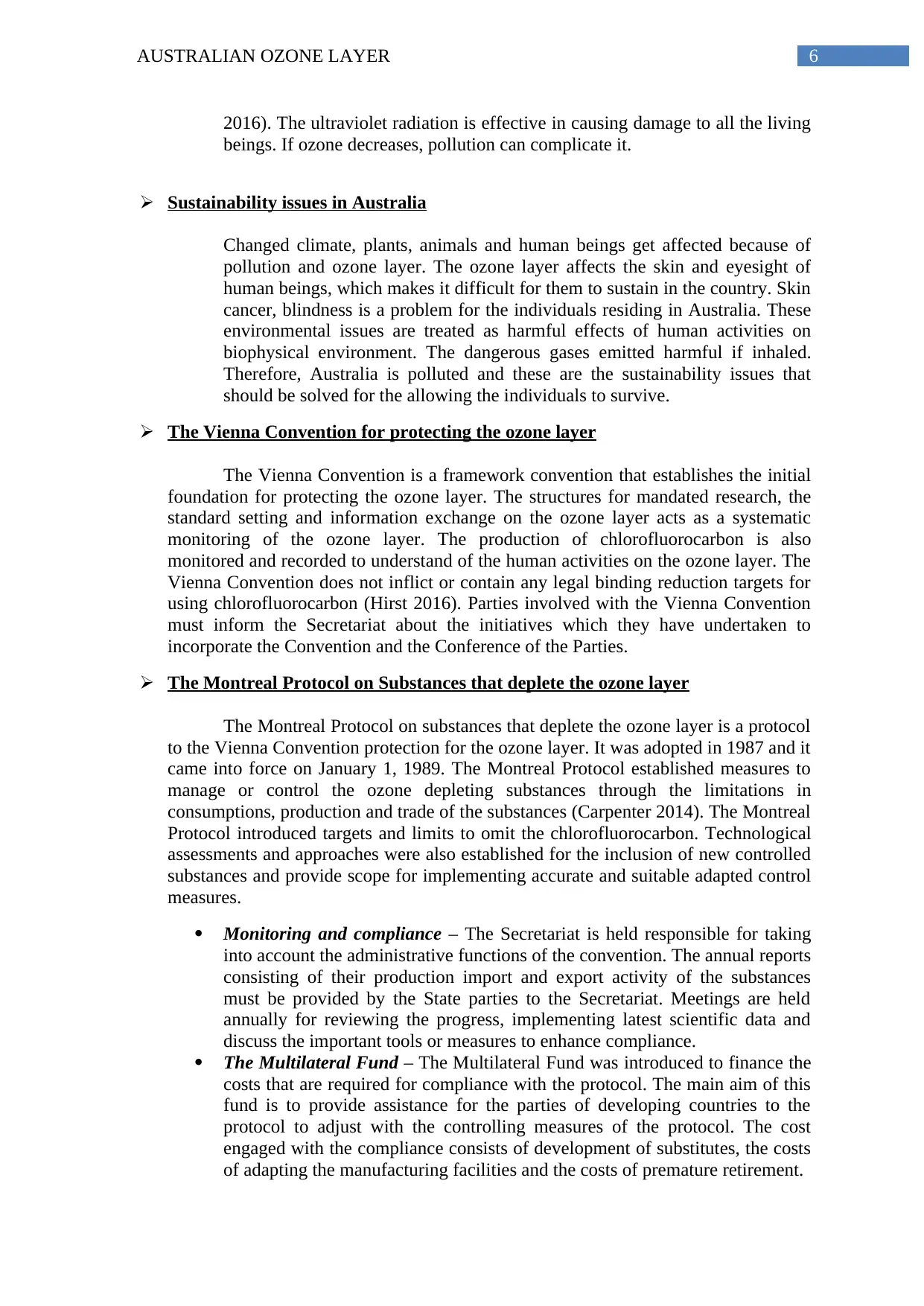
6AUSTRALIAN OZONE LAYER
2016). The ultraviolet radiation is effective in causing damage to all the living
beings. If ozone decreases, pollution can complicate it.
Sustainability issues in Australia
Changed climate, plants, animals and human beings get affected because of
pollution and ozone layer. The ozone layer affects the skin and eyesight of
human beings, which makes it difficult for them to sustain in the country. Skin
cancer, blindness is a problem for the individuals residing in Australia. These
environmental issues are treated as harmful effects of human activities on
biophysical environment. The dangerous gases emitted harmful if inhaled.
Therefore, Australia is polluted and these are the sustainability issues that
should be solved for the allowing the individuals to survive.
The Vienna Convention for protecting the ozone layer
The Vienna Convention is a framework convention that establishes the initial
foundation for protecting the ozone layer. The structures for mandated research, the
standard setting and information exchange on the ozone layer acts as a systematic
monitoring of the ozone layer. The production of chlorofluorocarbon is also
monitored and recorded to understand of the human activities on the ozone layer. The
Vienna Convention does not inflict or contain any legal binding reduction targets for
using chlorofluorocarbon (Hirst 2016). Parties involved with the Vienna Convention
must inform the Secretariat about the initiatives which they have undertaken to
incorporate the Convention and the Conference of the Parties.
The Montreal Protocol on Substances that deplete the ozone layer
The Montreal Protocol on substances that deplete the ozone layer is a protocol
to the Vienna Convention protection for the ozone layer. It was adopted in 1987 and it
came into force on January 1, 1989. The Montreal Protocol established measures to
manage or control the ozone depleting substances through the limitations in
consumptions, production and trade of the substances (Carpenter 2014). The Montreal
Protocol introduced targets and limits to omit the chlorofluorocarbon. Technological
assessments and approaches were also established for the inclusion of new controlled
substances and provide scope for implementing accurate and suitable adapted control
measures.
Monitoring and compliance – The Secretariat is held responsible for taking
into account the administrative functions of the convention. The annual reports
consisting of their production import and export activity of the substances
must be provided by the State parties to the Secretariat. Meetings are held
annually for reviewing the progress, implementing latest scientific data and
discuss the important tools or measures to enhance compliance.
The Multilateral Fund – The Multilateral Fund was introduced to finance the
costs that are required for compliance with the protocol. The main aim of this
fund is to provide assistance for the parties of developing countries to the
protocol to adjust with the controlling measures of the protocol. The cost
engaged with the compliance consists of development of substitutes, the costs
of adapting the manufacturing facilities and the costs of premature retirement.
2016). The ultraviolet radiation is effective in causing damage to all the living
beings. If ozone decreases, pollution can complicate it.
Sustainability issues in Australia
Changed climate, plants, animals and human beings get affected because of
pollution and ozone layer. The ozone layer affects the skin and eyesight of
human beings, which makes it difficult for them to sustain in the country. Skin
cancer, blindness is a problem for the individuals residing in Australia. These
environmental issues are treated as harmful effects of human activities on
biophysical environment. The dangerous gases emitted harmful if inhaled.
Therefore, Australia is polluted and these are the sustainability issues that
should be solved for the allowing the individuals to survive.
The Vienna Convention for protecting the ozone layer
The Vienna Convention is a framework convention that establishes the initial
foundation for protecting the ozone layer. The structures for mandated research, the
standard setting and information exchange on the ozone layer acts as a systematic
monitoring of the ozone layer. The production of chlorofluorocarbon is also
monitored and recorded to understand of the human activities on the ozone layer. The
Vienna Convention does not inflict or contain any legal binding reduction targets for
using chlorofluorocarbon (Hirst 2016). Parties involved with the Vienna Convention
must inform the Secretariat about the initiatives which they have undertaken to
incorporate the Convention and the Conference of the Parties.
The Montreal Protocol on Substances that deplete the ozone layer
The Montreal Protocol on substances that deplete the ozone layer is a protocol
to the Vienna Convention protection for the ozone layer. It was adopted in 1987 and it
came into force on January 1, 1989. The Montreal Protocol established measures to
manage or control the ozone depleting substances through the limitations in
consumptions, production and trade of the substances (Carpenter 2014). The Montreal
Protocol introduced targets and limits to omit the chlorofluorocarbon. Technological
assessments and approaches were also established for the inclusion of new controlled
substances and provide scope for implementing accurate and suitable adapted control
measures.
Monitoring and compliance – The Secretariat is held responsible for taking
into account the administrative functions of the convention. The annual reports
consisting of their production import and export activity of the substances
must be provided by the State parties to the Secretariat. Meetings are held
annually for reviewing the progress, implementing latest scientific data and
discuss the important tools or measures to enhance compliance.
The Multilateral Fund – The Multilateral Fund was introduced to finance the
costs that are required for compliance with the protocol. The main aim of this
fund is to provide assistance for the parties of developing countries to the
protocol to adjust with the controlling measures of the protocol. The cost
engaged with the compliance consists of development of substitutes, the costs
of adapting the manufacturing facilities and the costs of premature retirement.
Paraphrase This Document
Need a fresh take? Get an instant paraphrase of this document with our AI Paraphraser
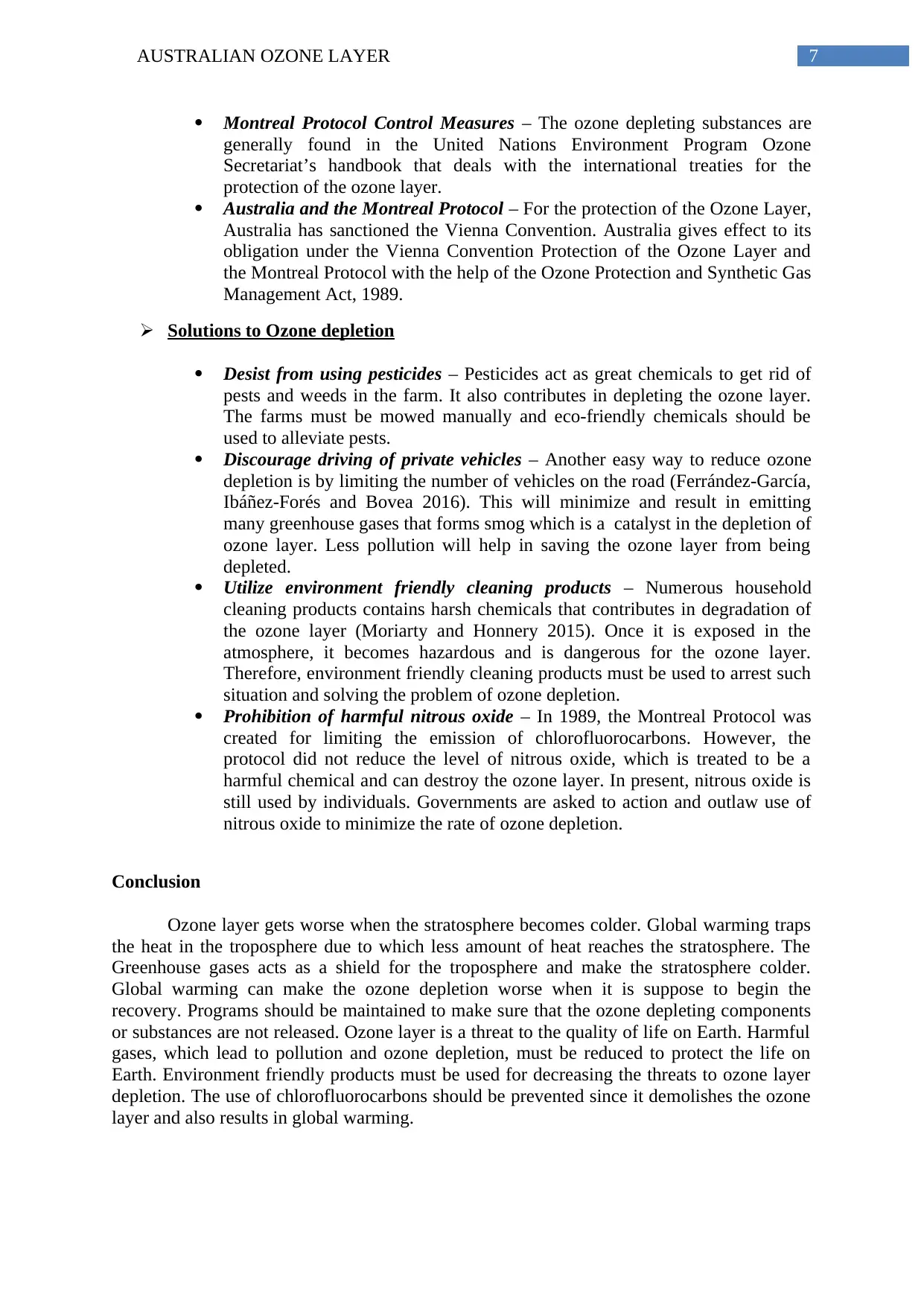
7AUSTRALIAN OZONE LAYER
Montreal Protocol Control Measures – The ozone depleting substances are
generally found in the United Nations Environment Program Ozone
Secretariat’s handbook that deals with the international treaties for the
protection of the ozone layer.
Australia and the Montreal Protocol – For the protection of the Ozone Layer,
Australia has sanctioned the Vienna Convention. Australia gives effect to its
obligation under the Vienna Convention Protection of the Ozone Layer and
the Montreal Protocol with the help of the Ozone Protection and Synthetic Gas
Management Act, 1989.
Solutions to Ozone depletion
Desist from using pesticides – Pesticides act as great chemicals to get rid of
pests and weeds in the farm. It also contributes in depleting the ozone layer.
The farms must be mowed manually and eco-friendly chemicals should be
used to alleviate pests.
Discourage driving of private vehicles – Another easy way to reduce ozone
depletion is by limiting the number of vehicles on the road (Ferrández-García,
Ibáñez-Forés and Bovea 2016). This will minimize and result in emitting
many greenhouse gases that forms smog which is a catalyst in the depletion of
ozone layer. Less pollution will help in saving the ozone layer from being
depleted.
Utilize environment friendly cleaning products – Numerous household
cleaning products contains harsh chemicals that contributes in degradation of
the ozone layer (Moriarty and Honnery 2015). Once it is exposed in the
atmosphere, it becomes hazardous and is dangerous for the ozone layer.
Therefore, environment friendly cleaning products must be used to arrest such
situation and solving the problem of ozone depletion.
Prohibition of harmful nitrous oxide – In 1989, the Montreal Protocol was
created for limiting the emission of chlorofluorocarbons. However, the
protocol did not reduce the level of nitrous oxide, which is treated to be a
harmful chemical and can destroy the ozone layer. In present, nitrous oxide is
still used by individuals. Governments are asked to action and outlaw use of
nitrous oxide to minimize the rate of ozone depletion.
Conclusion
Ozone layer gets worse when the stratosphere becomes colder. Global warming traps
the heat in the troposphere due to which less amount of heat reaches the stratosphere. The
Greenhouse gases acts as a shield for the troposphere and make the stratosphere colder.
Global warming can make the ozone depletion worse when it is suppose to begin the
recovery. Programs should be maintained to make sure that the ozone depleting components
or substances are not released. Ozone layer is a threat to the quality of life on Earth. Harmful
gases, which lead to pollution and ozone depletion, must be reduced to protect the life on
Earth. Environment friendly products must be used for decreasing the threats to ozone layer
depletion. The use of chlorofluorocarbons should be prevented since it demolishes the ozone
layer and also results in global warming.
Montreal Protocol Control Measures – The ozone depleting substances are
generally found in the United Nations Environment Program Ozone
Secretariat’s handbook that deals with the international treaties for the
protection of the ozone layer.
Australia and the Montreal Protocol – For the protection of the Ozone Layer,
Australia has sanctioned the Vienna Convention. Australia gives effect to its
obligation under the Vienna Convention Protection of the Ozone Layer and
the Montreal Protocol with the help of the Ozone Protection and Synthetic Gas
Management Act, 1989.
Solutions to Ozone depletion
Desist from using pesticides – Pesticides act as great chemicals to get rid of
pests and weeds in the farm. It also contributes in depleting the ozone layer.
The farms must be mowed manually and eco-friendly chemicals should be
used to alleviate pests.
Discourage driving of private vehicles – Another easy way to reduce ozone
depletion is by limiting the number of vehicles on the road (Ferrández-García,
Ibáñez-Forés and Bovea 2016). This will minimize and result in emitting
many greenhouse gases that forms smog which is a catalyst in the depletion of
ozone layer. Less pollution will help in saving the ozone layer from being
depleted.
Utilize environment friendly cleaning products – Numerous household
cleaning products contains harsh chemicals that contributes in degradation of
the ozone layer (Moriarty and Honnery 2015). Once it is exposed in the
atmosphere, it becomes hazardous and is dangerous for the ozone layer.
Therefore, environment friendly cleaning products must be used to arrest such
situation and solving the problem of ozone depletion.
Prohibition of harmful nitrous oxide – In 1989, the Montreal Protocol was
created for limiting the emission of chlorofluorocarbons. However, the
protocol did not reduce the level of nitrous oxide, which is treated to be a
harmful chemical and can destroy the ozone layer. In present, nitrous oxide is
still used by individuals. Governments are asked to action and outlaw use of
nitrous oxide to minimize the rate of ozone depletion.
Conclusion
Ozone layer gets worse when the stratosphere becomes colder. Global warming traps
the heat in the troposphere due to which less amount of heat reaches the stratosphere. The
Greenhouse gases acts as a shield for the troposphere and make the stratosphere colder.
Global warming can make the ozone depletion worse when it is suppose to begin the
recovery. Programs should be maintained to make sure that the ozone depleting components
or substances are not released. Ozone layer is a threat to the quality of life on Earth. Harmful
gases, which lead to pollution and ozone depletion, must be reduced to protect the life on
Earth. Environment friendly products must be used for decreasing the threats to ozone layer
depletion. The use of chlorofluorocarbons should be prevented since it demolishes the ozone
layer and also results in global warming.
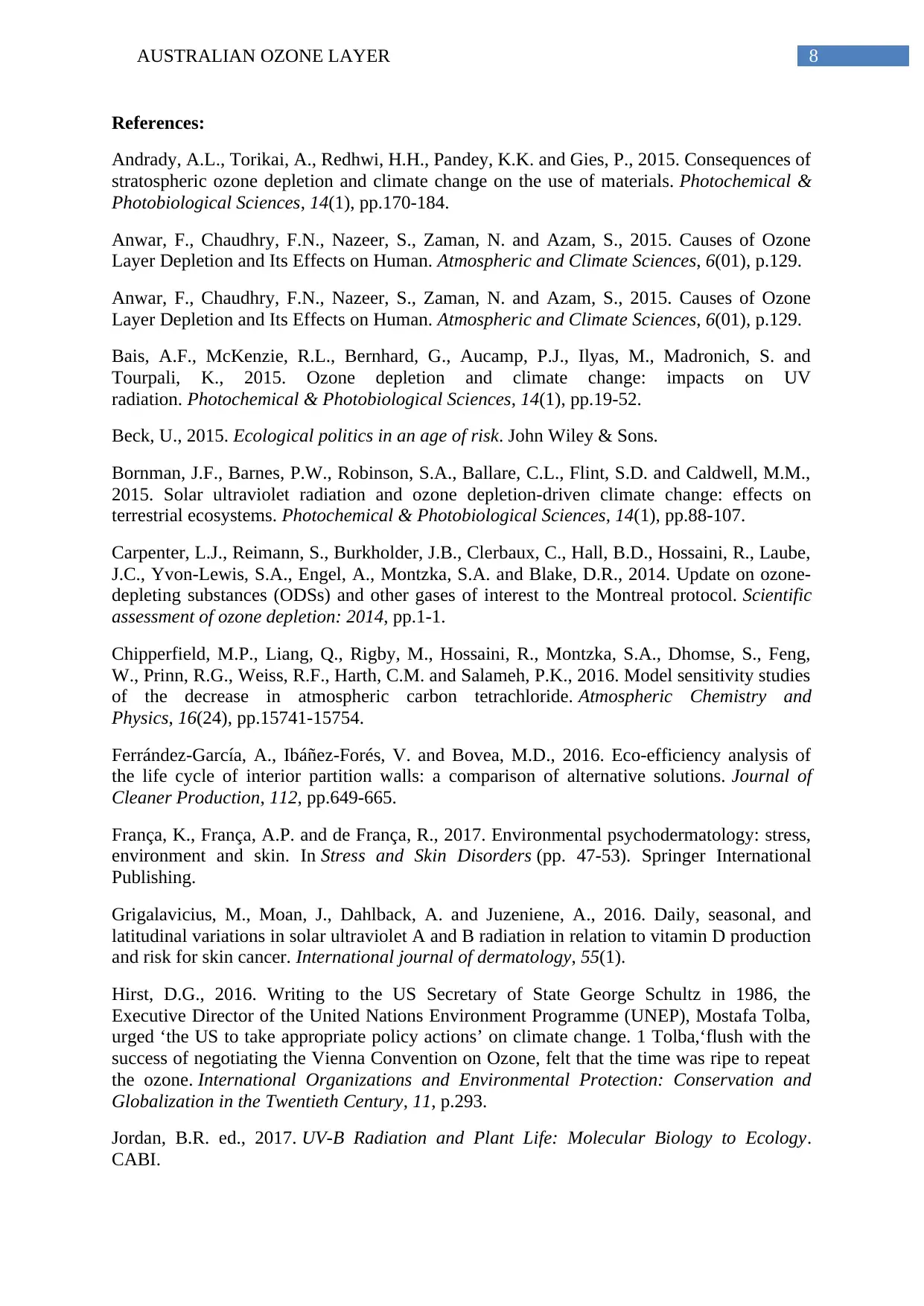
8AUSTRALIAN OZONE LAYER
References:
Andrady, A.L., Torikai, A., Redhwi, H.H., Pandey, K.K. and Gies, P., 2015. Consequences of
stratospheric ozone depletion and climate change on the use of materials. Photochemical &
Photobiological Sciences, 14(1), pp.170-184.
Anwar, F., Chaudhry, F.N., Nazeer, S., Zaman, N. and Azam, S., 2015. Causes of Ozone
Layer Depletion and Its Effects on Human. Atmospheric and Climate Sciences, 6(01), p.129.
Anwar, F., Chaudhry, F.N., Nazeer, S., Zaman, N. and Azam, S., 2015. Causes of Ozone
Layer Depletion and Its Effects on Human. Atmospheric and Climate Sciences, 6(01), p.129.
Bais, A.F., McKenzie, R.L., Bernhard, G., Aucamp, P.J., Ilyas, M., Madronich, S. and
Tourpali, K., 2015. Ozone depletion and climate change: impacts on UV
radiation. Photochemical & Photobiological Sciences, 14(1), pp.19-52.
Beck, U., 2015. Ecological politics in an age of risk. John Wiley & Sons.
Bornman, J.F., Barnes, P.W., Robinson, S.A., Ballare, C.L., Flint, S.D. and Caldwell, M.M.,
2015. Solar ultraviolet radiation and ozone depletion-driven climate change: effects on
terrestrial ecosystems. Photochemical & Photobiological Sciences, 14(1), pp.88-107.
Carpenter, L.J., Reimann, S., Burkholder, J.B., Clerbaux, C., Hall, B.D., Hossaini, R., Laube,
J.C., Yvon-Lewis, S.A., Engel, A., Montzka, S.A. and Blake, D.R., 2014. Update on ozone-
depleting substances (ODSs) and other gases of interest to the Montreal protocol. Scientific
assessment of ozone depletion: 2014, pp.1-1.
Chipperfield, M.P., Liang, Q., Rigby, M., Hossaini, R., Montzka, S.A., Dhomse, S., Feng,
W., Prinn, R.G., Weiss, R.F., Harth, C.M. and Salameh, P.K., 2016. Model sensitivity studies
of the decrease in atmospheric carbon tetrachloride. Atmospheric Chemistry and
Physics, 16(24), pp.15741-15754.
Ferrández-García, A., Ibáñez-Forés, V. and Bovea, M.D., 2016. Eco-efficiency analysis of
the life cycle of interior partition walls: a comparison of alternative solutions. Journal of
Cleaner Production, 112, pp.649-665.
França, K., França, A.P. and de França, R., 2017. Environmental psychodermatology: stress,
environment and skin. In Stress and Skin Disorders (pp. 47-53). Springer International
Publishing.
Grigalavicius, M., Moan, J., Dahlback, A. and Juzeniene, A., 2016. Daily, seasonal, and
latitudinal variations in solar ultraviolet A and B radiation in relation to vitamin D production
and risk for skin cancer. International journal of dermatology, 55(1).
Hirst, D.G., 2016. Writing to the US Secretary of State George Schultz in 1986, the
Executive Director of the United Nations Environment Programme (UNEP), Mostafa Tolba,
urged ‘the US to take appropriate policy actions’ on climate change. 1 Tolba,‘flush with the
success of negotiating the Vienna Convention on Ozone, felt that the time was ripe to repeat
the ozone. International Organizations and Environmental Protection: Conservation and
Globalization in the Twentieth Century, 11, p.293.
Jordan, B.R. ed., 2017. UV-B Radiation and Plant Life: Molecular Biology to Ecology.
CABI.
References:
Andrady, A.L., Torikai, A., Redhwi, H.H., Pandey, K.K. and Gies, P., 2015. Consequences of
stratospheric ozone depletion and climate change on the use of materials. Photochemical &
Photobiological Sciences, 14(1), pp.170-184.
Anwar, F., Chaudhry, F.N., Nazeer, S., Zaman, N. and Azam, S., 2015. Causes of Ozone
Layer Depletion and Its Effects on Human. Atmospheric and Climate Sciences, 6(01), p.129.
Anwar, F., Chaudhry, F.N., Nazeer, S., Zaman, N. and Azam, S., 2015. Causes of Ozone
Layer Depletion and Its Effects on Human. Atmospheric and Climate Sciences, 6(01), p.129.
Bais, A.F., McKenzie, R.L., Bernhard, G., Aucamp, P.J., Ilyas, M., Madronich, S. and
Tourpali, K., 2015. Ozone depletion and climate change: impacts on UV
radiation. Photochemical & Photobiological Sciences, 14(1), pp.19-52.
Beck, U., 2015. Ecological politics in an age of risk. John Wiley & Sons.
Bornman, J.F., Barnes, P.W., Robinson, S.A., Ballare, C.L., Flint, S.D. and Caldwell, M.M.,
2015. Solar ultraviolet radiation and ozone depletion-driven climate change: effects on
terrestrial ecosystems. Photochemical & Photobiological Sciences, 14(1), pp.88-107.
Carpenter, L.J., Reimann, S., Burkholder, J.B., Clerbaux, C., Hall, B.D., Hossaini, R., Laube,
J.C., Yvon-Lewis, S.A., Engel, A., Montzka, S.A. and Blake, D.R., 2014. Update on ozone-
depleting substances (ODSs) and other gases of interest to the Montreal protocol. Scientific
assessment of ozone depletion: 2014, pp.1-1.
Chipperfield, M.P., Liang, Q., Rigby, M., Hossaini, R., Montzka, S.A., Dhomse, S., Feng,
W., Prinn, R.G., Weiss, R.F., Harth, C.M. and Salameh, P.K., 2016. Model sensitivity studies
of the decrease in atmospheric carbon tetrachloride. Atmospheric Chemistry and
Physics, 16(24), pp.15741-15754.
Ferrández-García, A., Ibáñez-Forés, V. and Bovea, M.D., 2016. Eco-efficiency analysis of
the life cycle of interior partition walls: a comparison of alternative solutions. Journal of
Cleaner Production, 112, pp.649-665.
França, K., França, A.P. and de França, R., 2017. Environmental psychodermatology: stress,
environment and skin. In Stress and Skin Disorders (pp. 47-53). Springer International
Publishing.
Grigalavicius, M., Moan, J., Dahlback, A. and Juzeniene, A., 2016. Daily, seasonal, and
latitudinal variations in solar ultraviolet A and B radiation in relation to vitamin D production
and risk for skin cancer. International journal of dermatology, 55(1).
Hirst, D.G., 2016. Writing to the US Secretary of State George Schultz in 1986, the
Executive Director of the United Nations Environment Programme (UNEP), Mostafa Tolba,
urged ‘the US to take appropriate policy actions’ on climate change. 1 Tolba,‘flush with the
success of negotiating the Vienna Convention on Ozone, felt that the time was ripe to repeat
the ozone. International Organizations and Environmental Protection: Conservation and
Globalization in the Twentieth Century, 11, p.293.
Jordan, B.R. ed., 2017. UV-B Radiation and Plant Life: Molecular Biology to Ecology.
CABI.
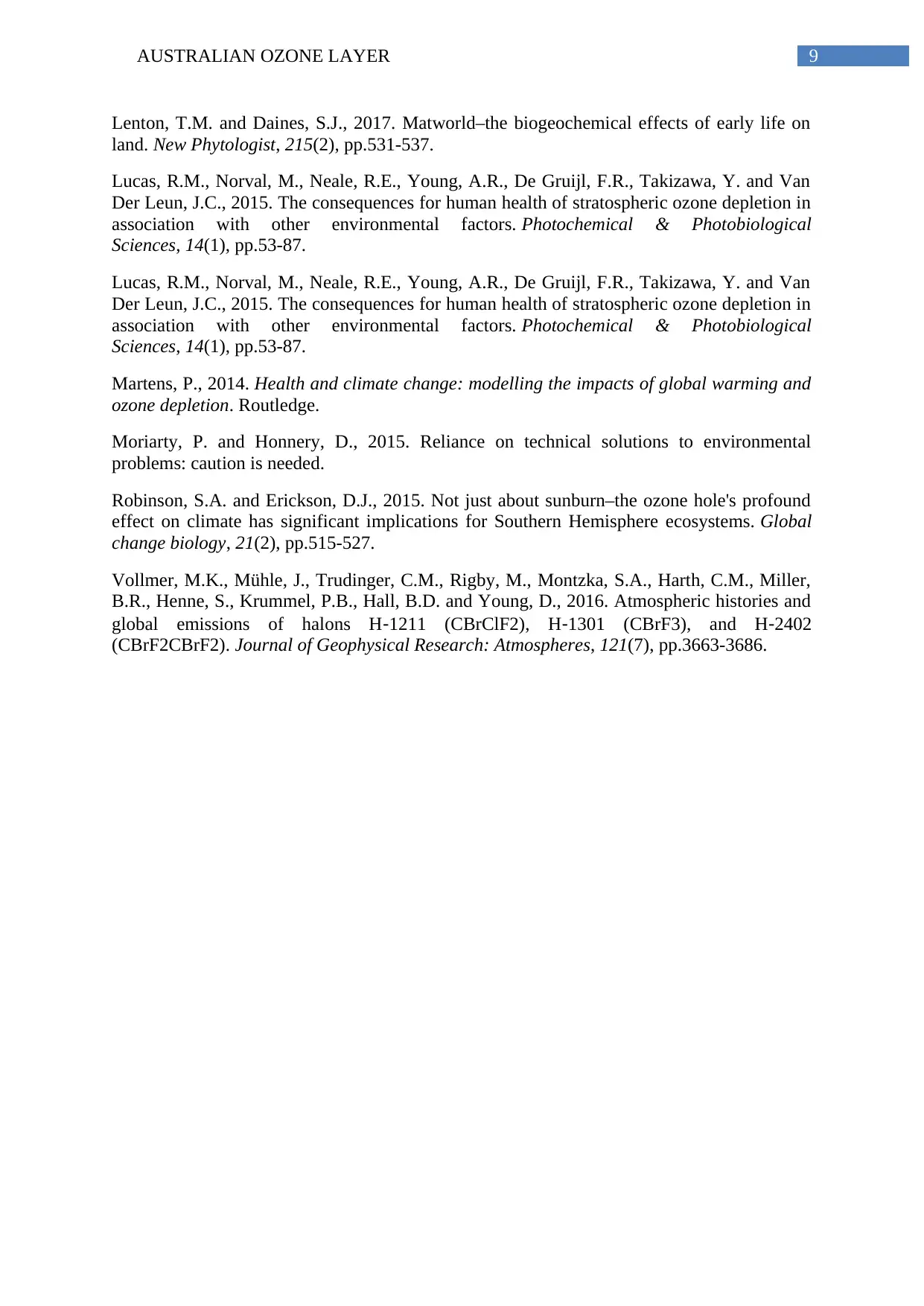
9AUSTRALIAN OZONE LAYER
Lenton, T.M. and Daines, S.J., 2017. Matworld–the biogeochemical effects of early life on
land. New Phytologist, 215(2), pp.531-537.
Lucas, R.M., Norval, M., Neale, R.E., Young, A.R., De Gruijl, F.R., Takizawa, Y. and Van
Der Leun, J.C., 2015. The consequences for human health of stratospheric ozone depletion in
association with other environmental factors. Photochemical & Photobiological
Sciences, 14(1), pp.53-87.
Lucas, R.M., Norval, M., Neale, R.E., Young, A.R., De Gruijl, F.R., Takizawa, Y. and Van
Der Leun, J.C., 2015. The consequences for human health of stratospheric ozone depletion in
association with other environmental factors. Photochemical & Photobiological
Sciences, 14(1), pp.53-87.
Martens, P., 2014. Health and climate change: modelling the impacts of global warming and
ozone depletion. Routledge.
Moriarty, P. and Honnery, D., 2015. Reliance on technical solutions to environmental
problems: caution is needed.
Robinson, S.A. and Erickson, D.J., 2015. Not just about sunburn–the ozone hole's profound
effect on climate has significant implications for Southern Hemisphere ecosystems. Global
change biology, 21(2), pp.515-527.
Vollmer, M.K., Mühle, J., Trudinger, C.M., Rigby, M., Montzka, S.A., Harth, C.M., Miller,
B.R., Henne, S., Krummel, P.B., Hall, B.D. and Young, D., 2016. Atmospheric histories and
global emissions of halons H‐1211 (CBrClF2), H‐1301 (CBrF3), and H‐2402
(CBrF2CBrF2). Journal of Geophysical Research: Atmospheres, 121(7), pp.3663-3686.
Lenton, T.M. and Daines, S.J., 2017. Matworld–the biogeochemical effects of early life on
land. New Phytologist, 215(2), pp.531-537.
Lucas, R.M., Norval, M., Neale, R.E., Young, A.R., De Gruijl, F.R., Takizawa, Y. and Van
Der Leun, J.C., 2015. The consequences for human health of stratospheric ozone depletion in
association with other environmental factors. Photochemical & Photobiological
Sciences, 14(1), pp.53-87.
Lucas, R.M., Norval, M., Neale, R.E., Young, A.R., De Gruijl, F.R., Takizawa, Y. and Van
Der Leun, J.C., 2015. The consequences for human health of stratospheric ozone depletion in
association with other environmental factors. Photochemical & Photobiological
Sciences, 14(1), pp.53-87.
Martens, P., 2014. Health and climate change: modelling the impacts of global warming and
ozone depletion. Routledge.
Moriarty, P. and Honnery, D., 2015. Reliance on technical solutions to environmental
problems: caution is needed.
Robinson, S.A. and Erickson, D.J., 2015. Not just about sunburn–the ozone hole's profound
effect on climate has significant implications for Southern Hemisphere ecosystems. Global
change biology, 21(2), pp.515-527.
Vollmer, M.K., Mühle, J., Trudinger, C.M., Rigby, M., Montzka, S.A., Harth, C.M., Miller,
B.R., Henne, S., Krummel, P.B., Hall, B.D. and Young, D., 2016. Atmospheric histories and
global emissions of halons H‐1211 (CBrClF2), H‐1301 (CBrF3), and H‐2402
(CBrF2CBrF2). Journal of Geophysical Research: Atmospheres, 121(7), pp.3663-3686.
1 out of 10
Related Documents
Your All-in-One AI-Powered Toolkit for Academic Success.
+13062052269
info@desklib.com
Available 24*7 on WhatsApp / Email
![[object Object]](/_next/static/media/star-bottom.7253800d.svg)
Unlock your academic potential
© 2024 | Zucol Services PVT LTD | All rights reserved.





